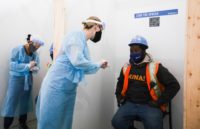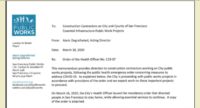With case numbers rising, emergency, temporary new COVID-19 safety standards are set to go into effect by Nov. 30 for California workplaces.
But the state Occupational Safety and Health Standards Board rules are again causing confusion—with added employer requirements to create written virus prevention programs that include notification, testing and reporting components on top of current local mandates that vary across cities and counties.
The seven-member board, appointed by Gov. Gavin Newsom, adopted the emergency standards as record COVID-19 cases prompted alarm across the state’s 58 counties about the sources of spread. The standards will apply to most workers not covered by Cal/OSHA’s Aerosol Transmissible Diseases standard. The state Office of Administrative Law has 10 days to review and approve the new rules, but they are expected to be in effect by the end of the month.
The new regulations call for employers to have a written COVID-19 prevention plan that includes:
- A communication system that informs employees “about COVID-19 prevention procedures, testing, symptoms and illnesses, including a system for employees to report exposures without fear of retaliation”
- Worker symptom screening and potential workplace exposure identification
- COVID-19 case investigation and immediate response to potential exposures with steps to determine and notify workers in one business day
- Employer-offered testing for potentially-exposed workers
- COVID-19 hazards training and instruction
- Physical distancing
- Mandatory employer-provided face coverings
- Site-specific strategies including workplace and schedule changes and providing personal protective equipment
- Positive COVID-19 case and illness recording requirements
- COVID-19 prevention plans that are accessible to employees and employee representatives
- Removal of COVID-19 exposed workers and COVID-19 positive workers from the workplace with measures to protect pay and benefits
- Criteria for recovering employees to return to work
- Testing and notifying public health departments of workplace outbreaks (defined as three or more cases in a workplace in a 14-day period) and major outbreaks (defined as 20 or more cases within a 30-day period)
Kate Mergen, vice president of legislative affairs at Associated General Contractors of California, which represents over 1,000 contractors, says much of what the emergency regulation requires is already in place, “but it is the testing and the reporting requirements that are going to add another level of initial confusion. Ten days is not enough time for companies to comply, educate workers and structure in an impactful way."
Mergen expects testing administration and availability to be a challenge in the event of a major COVID-19 outbreak. “The regulation does not go into detail on the definition of the workplace and it is not clear exactly what the requirements will be when it comes to construction jobsites,” Mergen says.
Time Needed for Review
Emily Cohen, United Contractors’ executive vice president, agrees that the safety board did not allow enough time for stakeholders to review and provide input before the order takes effect. She is concerned about the impact that the 10-day turnaround could have on small businesses. The industry group, which represents more than 500 union-affiliated heavy civil engineering and construction employers who perform about $40 billion in projects annually, registered its concerns with the board and Cal/OSHA in a Nov. 18 letter.
“Our primary concern is that the proposed regulations are duplicative and contradictive in some areas, which will cause confusion and place contractors in a position of having to comply with multiple requirements all aimed at the same result,” wrote Mark Breslin, CEO of UCON, in the letter.
Meanwhile, the rising case numbers prompted counties to implement more restrictive measures than those in the state’s color-coded Blueprint for a Safer Economy. With Los Angeles and other areas on the brink of a new stay-at-home order, there is some concern about what work will continue or be restricted.
“Based on COVID-19 surges around the state, we are anticipating a potential stay at home order,” Cohen says. “In that case, we will advocate for construction to remain essential work.” The state’s essential worker clause and definition at the beginning of the pandemic caused confusion across industries.
Mergen says clarification is needed on employees working from home, whom the regulation says are an exception.
“We would like to have language that addresses our hybrid workers (those who are going into the workplace part of the time and working from home part of the time) and also remote employees who may be out in the field or in a separate area of the workplace,” she says, also noting the regulation’s definition of “exposed workplace” and its employer notice requirements should align with established state labor code that addresses COVID-19.






Post a comment to this article
Report Abusive Comment